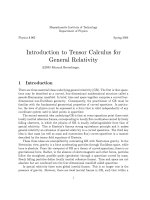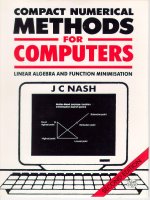Introduction to Numerical Methods for Diferentia
Bạn đang xem bản rút gọn của tài liệu. Xem và tải ngay bản đầy đủ của tài liệu tại đây (708.47 KB, 76 trang )
Lecture 3
Introduction to Numerical Methods for Differential
and Differential Algebraic Equations
Dr. Abebe Geletu
Ilmenau University of Technology
Department of Simulation and Optimal Processes (SOP)
Winter Semester 2011/12
Lecture 3 Introduction to Numerical Methods for Differential and Differential Algebraic Equations
TU Ilmenau
Topics
Newton’s Law:
m¨
x = − Fl x
m¨
y = mg Fl y
Conservation of mechanical
energy: x2 + y 2 = l2
(DAE)
x˙ 1 = x3
x˙ 2 = x4
F
x1
ml
F
x˙ 4 = g x2
l
0 = x2 + y 2 − l 2 .
x˙ 3 = −
1
2
Numerical Methods of Ordinary Differential Equations
Initial Value Problems (IVPs)
Lecture 3 Introduction1 to Numerical Methods for Differential and Differential Algebraic Equations
TU Ilmenau
Single Step Methods
Multi-step Methods
Initial Value Problems
General form of an initial value problem (IVP) is
x(t)
˙
= f (t, x(t)), t0 ≤ t ≤ tf ,
(1)
x(t0 ) = x0
(2)
(given),
where x and f can be vector functions:
f1 (t, x(t))
x1 (t)
x2 (t)
f2 (t, x(t))
x(t) = . , f (t, x(t)) =
.
..
.
.
.
xn (t)
fn (t, x(t))
If f is (explicitly) time independent; i.e. f (t, x(t)) = f (x(t)), then
the system (1) - (2) is said to be autonomous.
Lecture 3 Introduction to Numerical Methods for Differential and Differential Algebraic Equations
TU Ilmenau
x(t0 ) = x0 is the initial condition (start time of the motion)
The expression x(t)
˙
represents the first order derivative of x(t)
d
with respect to time; i.e. x(t)
˙
= dt
x(t). Thus, the IVP (1) - (2)
represents a system of first order differential equations.
If f (t, x(t)) = A(t)x(t), then we have
x(t)
˙
= A(t)x(t), x(t0 ) = x0 is a first order linear IVP. In the
autonomous case we have A(t) = A.
Example: Equation of motion of a simple pendulum:
θ˙ = ω
g
ω˙ = − sin(θ)
L
⇒
θ˙
ω˙
=
ω
− Lg sin(θ)
Lecture 3 Introduction to Numerical Methods for Differential and Differential Algebraic Equations
TU Ilmenau
,
θ(0) = π4
ω(0) = 0
Commonly, numerical methods are developed for systems of first
order differential equations.
⇒ any higher order differential equation should be written as a
system of first order differential equations.
NB: The Matlab ODE Toolbox works only with systems of first order
differential equations.
Strategy: Convert any n-th order initial value problem into a system
of first-order IVP by introduction new variables.
dx d2 x
dn−1 x
, 2 , . . . , n−1
dt dt
dt
dx(t)
dn−1 x(t)
x(t0 ) = a1 , x(t
˙ 0 ) = a2 ,
= a3 , . . . ,
dt t=t0
dtn−1
dn x(t)
=f
dtn
t,
Introduce new variables:
2
x1 = x, x2 = x,
˙ x3 = d dtx(t)
2 , . . . , xn =
dn−1 x(t)
.
dtn−1
Lecture 3 Introduction to Numerical Methods for Differential and Differential Algebraic Equations
TU Ilmenau
= an .
t=t0
Then the n-th order IVP reduces to
x˙ 1 = x2 ,
x1 (t0 ) = a1
x˙ 2 = x3 ,
..
.
x2 (t0 ) = a2
x˙ n = f (t, x1 , x2 , . . . , xn ), xn (t0 ) = an .
Example: The equation of motion of a simple pendulum (neglecting
air resistance) with mass m is a 2nd-order equation
mLθ¨ + mg sin(θ(t)) = 0,
(3)
˙
θ(t0 ) = θ0 , θ = ω0 .
(4)
˙ Then
Introduce ω = θ.
θ˙ = ω,
θ(t0 ) = θ0
g
ω˙ = − sin(θ), ω(t0 ) = ω0 .
L
Lecture 3 Introduction to Numerical Methods for Differential and Differential Algebraic Equations
TU Ilmenau
Objective:
To determine a continuous function x∗ (t) that satisfies the dynamic
equation (1); i.e. x∗ (t) = f (t, x∗ (t)) and the initial condition (2); i.e.
x∗ (t0 ) = x0 .
!!! In general, the solution function x∗ (t) of the IVP is not easy to be
analytically determined.
Lecture 3 Introduction to Numerical Methods for Differential and Differential Algebraic Equations
TU Ilmenau
Basic idea of numerical solution of differential equations:
Select a set of equally spaced time points t1 , t2 , . . . , tN from the
interval [t0 , tf ] (tf freely chosen for IVPs). That is, t1 = t0 + h ,
t2 = t1 + h, and so on; so that h = tk+1 − tk , k = 0, 1, . . . , N − 1.
Approximate the continuous solution x∗ (t) of (1) & (2) by values
at the discrete time points t1 , t2 , . . . , tN ; i.e.
x(t1 ) = x1 , x(t2 ) = x2 , . . . , x(tN ) = xN .
determine the values x1 , x2 , . . . , xN through the IVP (1) - (2).
Note:
more discretization points from [t0 , tf ] implies
better accuracy of the approximation; but
demands more computation effort,
depending on the algorithm used, it may be necessary to solve a
system of linear or nonlinear equations.
Lecture 3 Introduction to Numerical Methods for Differential and Differential Algebraic Equations
TU Ilmenau
Euler’s Method
Motivation: for a single IVP x(t)
˙
= f (t, x(t)), x(t0 ) = x0 ; i.e.
x(t) ∈ R, 0 ≤ t ≤ tf .
Given the point (t0 , x0 ) the value x(t
˙ 0) =
dx(t)
dt t=t
0
is the slope of
the tangent line to the graph of x(t) at the point (t0 , x0 ).
Figure: Euler’s Method
Lecture 3 Introduction to Numerical Methods for Differential and Differential Algebraic Equations
TU Ilmenau
Since the function x(t) is not yet known, the derivative (slope) can be
approximated by
x(t0 + h) − x(t0 )
x(t
˙ 0) ≈
h
Thus, using x(t
˙ 0 ) = f (t0 , x0 ), we have
x(t0 + h) − x(t0 )
= f (t0 , x(t0 ))
h
This implies
x(t0 + h) = x(t0 ) + hf (t0 , x(t0 ))
⇒
x1 = x(t1 ) = x(t0 + h) = x(t0 ) + hf (t0 , x(t0 ))
From this we obtain the value of x1 = x(t1 ). By the same procedure
x2 can be also determined.
In general, once xk is known, xk+1 can be found from
xk+1 = xk + hf (tk , xk ), k = 0, 1, . . . , m − 1.
Lecture 3 Introduction to Numerical Methods for Differential and Differential Algebraic Equations
TU Ilmenau
Euler’s Algorithm
Select N .
(t −t )
Set h = f N 0 ; x0 = x(t0 )
FOR k = 0 : (n − 1)
xk+1 = xk + hf (tk , xk );
tk+1 = tk + h;
ENDFOR.
Matlab:
function [t,x]=myEuler(@f,x0,t0,tf,N)
h=(tf-tn)/N;
t=[t0:h:tf]; %discrete time points between, and including,
x(1)=x0;
for k=2:N
x(k)=x(k-1) + h*feval(f,t(k-1),x(k-1));
end;
Lecture 3 Introduction to Numerical Methods for Differential and Differential Algebraic Equations
TU Ilmenau
Simple Pendulum with Euler’s Method
function time=MyPenEuler(N,tf)
t=cputime;
m=1;
L=9.81;
g=9.81;
beta=0;
t0=0;
theta0=(1/10)*pi;
omega0=0;
h=(tf-t0)/N;
tt=[t0:h:tf];
ttheta=zeros(size(tt));
oomega=zeros(size(tt));
ttheta(1)=theta0;
oomega(1)=omega0;
Lecture 3 Introduction to Numerical Methods for Differential and Differential Algebraic Equations
TU Ilmenau
Simple Pendulum with Euler’s Method...
for k=1:N
oomega(k+1)=oomega(k)+h*...
(-beta/m/L*oomega(k)-g/L*sin(ttheta(k)));
ttheta(k+1)=ttheta(k)+h*oomega(k);
end
time=cputime-t;
plot(tt,oomega,tt,ttheta)
title(’Simple pendulum using Euler’’s method’)
Lecture 3 Introduction to Numerical Methods for Differential and Differential Algebraic Equations
TU Ilmenau
Advantages/Disadvantages of Euler’s Method
Advantages:
Euler’s Method is simple and direct
Can be used for nonlinear IVPs
Disadvantages:
it is less accurate and numerically unstable.
Approximation error is proportional to the step size h. Hence,
good approximation is obtained with a very small h. This
requires a large number of time discretization leading to a larger
computation time.
Usually applicable to explicit differential equations.
Lecture 3 Introduction to Numerical Methods for Differential and Differential Algebraic Equations
TU Ilmenau
Improvements on Euler’s Method
(A) The Mid-Point Method
Let k1 = hf (ti , xi ).
Note that: k1 = hf (ti , xi ) = xi+1 − xi . But to compute k1 , it is not
necessary to know the value of xi+1 .
Figure: Use also the mid point
Lecture 3 Introduction to Numerical Methods for Differential and Differential Algebraic Equations
TU Ilmenau
Improvements on Euler’s Method...
• The point (ti + 21 ti , xi + 12 k1 ) is the mid-point of the segment that
connects the points (ti , xi ) and (ti+1 , xi+1 ).
• Now, instead of the single slope at (ti , xi ), we use the slopes at
(ti , xi ) and at (ti + 12 ti , xi + 12 k1 ) to approximate xi+1 .
⇒ This leads to the Mid-Point Runge-Kutta Algorithm:
The mid-point Runge-Kutta Method
k1 = hf (ti , xi )
1
1
k2 = hf (ti + h, xi + k1 )
2
2
xi+1 = xi + k2 .
Lecture 3 Introduction to Numerical Methods for Differential and Differential Algebraic Equations
TU Ilmenau
Improvements on Euler’s Method...
(B) Methods that use Intermediate Points
Question: Can we improve the mid-point RK method by freely
choosing any point from the segment connecting (ti , xi ) and
(ti+1 , xi+1 )?
Figure: Choose freely any intermediate point
Lecture 3 Introduction to Numerical Methods for Differential and Differential Algebraic Equations
TU Ilmenau
• A weighted sum of f (ti , xi ) and f (ti + ch, xi + mk1 ) provideds
more slope information than f (ti , xi ) alone.
Scheme:
(RK2)
x(t + h) = x(t) + hf (t, x)
where f (t, x) = [w1 f (t, x) + w2 f (t + ch, x + mk1 )] .
How to determine w1 , w2 , c and h?
We use:
(i) Taylor approximation of f (t + ch, x + mk1 ):
f (t + ch, x + mk1 ) = f (t, x) + chft (t, x) + mk1 fx (t, x)x
(∗)
Put this into (*) to obtain
x(t+h) = x(t)+h [w1 f (t, x) + w2 {f (t, x) + chft (t, x) + mk1 fx (t, x)})]
⇒ (with k1 = hf (t, x))
x(t+h) = x(t)+h (w1 + w2 ) f (t, x)+w2 ch2 ft (t, x)+mw2 h2 fx (t, x)f (t, x)
Lecture 3 Introduction to Numerical Methods for Differential and Differential Algebraic Equations
TU Ilmenau
Improvements on Euler’s Method...
(ii) 2nd- order Taylor approximation of x(t + h):
x(t + h) = x(t) + hx (t) +
h2
x (t)
2
(∗∗)
h2
x (t) (∗∗)
2
Recall x (t) = x(t)
˙
= f (t, x) ⇒ x (t) = ft (t, x) + fx (t, x)f (t, x).
Putting these into (**) we obtain
x(t + h) = x(t) + hx (t) +
x(t + h) = x(t) + hf (x, t) +
h2
h2
ft (t, x) + fx (t, x)f (t, x))
2
2
Comparing (*) and (**) we find
(∗∗)
w1 + w2 = 1, cw2 = 12 , mw2 = 12 .
A system of three equations with four unknowns ⇒ This system has
infinitely many solutions.
Lecture 3 Introduction to Numerical Methods for Differential and Differential Algebraic Equations
TU Ilmenau
Improvements on Euler’s Method...
• By fixing one of the unknowns w1 , w2 , c and m, we can solve the
system of equations for the other three.
⇒ Hence, we can construct several RK2 methods.
Example:
• If we fix w1 = 0, then w2 = 1, c = 12 and m = 21 . Hence, (RK2)
reduces to the mid-point RK2 method.
w1
0
w2
1
c
m
1
2
1
3
1
2
2
3
1
2
1
2
1
1
3
4
3
4
Method
Modified Euler Method
Heun’s Method
Ralston’s Method
Heun’s Method:
k1 = f (ti , xi )
xi+1 = xi + h 12 f (ti , xi ) + 12 f (ti + h, xi + k1 )
Lecture 3 Introduction to Numerical Methods for Differential and Differential Algebraic Equations
TU Ilmenau
Runge-Kutta Methods
The above schemes are known as second-order Runge-Kutta
methods, since x(t + h) has been approximated by a second degree
Taylor polynomial.
For an accurate approximation use more intermediate points
between (ti , xi ) and (ti + h, xi + k1 ) and include more slope
information.
Requires higher degree Taylor approximations of x(t + h).
Figure: Use several intermediate points
Lecture 3 Introduction to Numerical Methods for Differential and Differential Algebraic Equations
TU Ilmenau
Runge-Kutta Methods...
General Scheme:
[RK(m)]
xi+1 = xi + hf (ti , xi );
where
f (ti , xi ) = w1 f (ti , xi ) + w2 f (ti + α1 h, xi + β1 k1 ) + . . . + wm f (ti + αm h, xi + βm km ).
• The values k1 , k2 , . . . , km are found at the intermediate points.
• w1 + w2 + . . . + wm = 1.
• The relation between ω1 , . . . , ωm , α1 , . . . , αm , β1 , . . . , βm is
determined by comparing the m-th order Talyor approximation of
x(t + h) and the scheme RK(m)
Lecture 3 Introduction to Numerical Methods for Differential and Differential Algebraic Equations
TU Ilmenau
Hence, the resulting method is called an m-th order Runge-Kutta
method.
There are third-order Runge-Kutta (RK3), fourth-order
Runge-Kutta methods (RK4), etc.
The classical 4-th order Runge-Kutta Method has the form:
(RK4s) k1 = f (ti , xi )
1
1
k2 = hf (ti + h + xi + k1 )
2
2
1
1
k3 = hf (ti + h + xi + k2 )
2
2
k4 = hf (ti + h, xi + k3 )
1
1
1
1
xi+1 = xi + k1 + k2 + k3 + k4
6
3
3
6
Lecture 3 Introduction to Numerical Methods for Differential and Differential Algebraic Equations
TU Ilmenau
The classical 4th order Runge-Kutta Method
function myRK4(N,tf)
m=5; %Mass
L=9.81; %length of the string
g=9.81; %gravitaional acceleration
beta=0; %
t0=0;
theta0=(1/10)*pi;
omega0=0;
h=(tf-t0)/N
tt=[t0:h:tf];
ttheta=zeros(size(tt));
oomega=zeros(size(tt));
ttheta(1)=theta0;
oomega(1)=omega0;
Lecture 3 Introduction to Numerical Methods for Differential and Differential Algebraic Equations
TU Ilmenau
%The classic 4th order Runge Kutta method
for k=1:N
k1=h*(-beta/m/L*oomega(k)-g/L*sin(ttheta(k)));
m1=h*oomega(k);
k2=h*(-beta/m/L*(oomega(k)+k1/2)-g/L*(sin(ttheta(k)+m1/2
m2=h*(oomega(k)+m1/2);
k3=h*(-beta/m/L*(oomega(k)+k2/2)-g/L*(sin(ttheta(k)+m2/2
m3=h*(oomega(k)+k2/2);
k4=h*(-beta/m/L*(oomega(k)+k3/2)-g/L*(sin(ttheta(k)+m3/2
m4=h*(oomega(k)+k3);
oomega(k+1)=oomega(k)+1/6*(k1+2*k2+2*k3+k4);
ttheta(k+1)=ttheta(k)+1/6*(m1+2*m2+2*m3+m4);
end
% Plot the solutions.
plot(tt,oomega,tt,ttheta)
title(’Simple pendulum solved with 4th order Runge Kutta’)
Lecture 3 Introduction to Numerical Methods for Differential and Differential Algebraic Equations
TU Ilmenau









